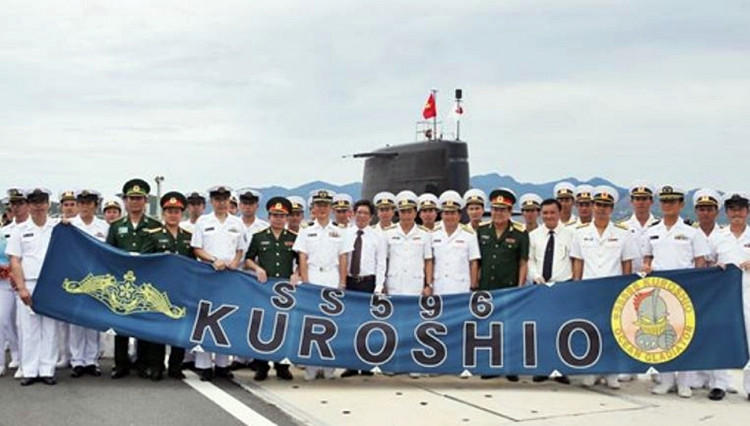In becoming the first Japanese submarine to visit Vietnam, JS Kuroshio (SS-596), an Oyashio-class diesel electric attack submarine of the Japan Maritime Self-Defense Force (JMSDF), has pointedly illustrated the growing military ties between Japan and Vietnam.
Taking a break from patrolling the South China Sea along with Escort Flotilla Four, Kuroshio surfaced off Cam Ranh International Port in Kham Hoa on Sept. 17, for what Vietnam said was as a scheduled five-day visit. Kuroshio's visit is historic since this is the first time a Japanese submarine has ever visited Vietnam.
Vietnam's Ministry of Defense said Kuroshio's port call is nothing extraordinary. It said the officers and sailors aboard the submarine made courtesy calls on Vietnamese officials and naval personnel; took part in sports games; did cultural activities such as sightseeing tours of th city of Nha Trang city and paid courtesy calls on leaders of Khanh Hoa province and the High Command of Naval Region 4 of the Vietnam People's Navy (VPN).
It said the Kuroshio's visit was part of activities celebrating the 45th founding anniversary of Vietnam-Japan diplomatic relations. The ministry also said the visit also enhanced mutual trust and understanding between the VPN and the JMSDF, helping deepen bilateral defense collaboration and contributing to peace, stability, and cooperation in the region.
Japanese military analysts, however, say there's more than meets the eye in the Kuroshio's visit. The submarine symbolizes the latest manifestation of both Vietnam and Japan's intention of building stronger intra-regional security relationships in the Asia-Pacific region to counter more aggressive military powers.
They said Vietnam's decision to permit a Japanese navy submarine to traverse its waters is significant. The Kuroshio's visit is clearly aimed at irritating Beijing, considering Vietnam's unyielding demand to own the Paracel Islands and several other features in the South China Sea now controlled by China. Another sign of warning military ties between Japan and Vietnam is that a VPN frigate will visit Japan this week.
The closer interactions between the JMSDF and the VPN are being seen by Japanese military analysts as a clear sign both navies are boosting their so-called "extensive strategic partnership." Vietnam regards Japan as a key military power to engage with as part of its broad "omni-directional foreign policy."
On the other hand, Japan sees Vietnam as a key pillar in its wider engagement with Southeast Asia. Vietnam is also a vital strategic piece in Japan's own Indo-Pacific strategy, which was formulated by Shinzo Abe when he first became prime minister in 2006.
Abe regained the premiership in 2012 and will continue as prime minister until 2021. Under Abe, the Japan Self-Defense Force (JSDF), of which the JMSDF is a part, has been playing a more active security role in the Indo-Pacific region.
Over the past years, the JMSDF and the VPN have conducted naval drills; made complementary port calls; signed an agreement on coast guard cooperation, and discussed more defense equipment and defense industrial collaboration.
JS Kuroshio (SS-596) is armed with American-made UGM-84 Harpoon over-the-horizon, anti-ship missiles, and huge Type 89 homing torpedoes that streak towards their warship targets as far as 50 km away at more than 100 km/h.
She recently joined Escort Flotilla Four, a JMDSF battle group currently patrolling the South China Sea in defiance of China and its claim to own 90% of this body of water. Escort Flotilla Four consists of the helicopter carrier JS Kaga (DDH-184) and two destroyers, JS Suzutsuki (DD-117) and JS Inazuma (DD-105). It's been patrolling the South China Sea since August as part of Japan's own freedom of navigation operations (FONOPS).






